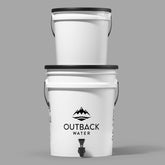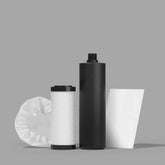Electro-Adhesion at Work
Electro-Adhesion Technology (EAT)
In the process of creating any new technology, be it in electronics, medicine, or in water filtration, the inventor can be assured of one thing - there will be a great deal of trial and error throughout the developmental stages. This has certainly been the case in the creation and evolution of Electro-Adhesion Technology (EAT). But now, this technology's break-through in materials science synergistically combines the best aspects of both electrically charged material and mechanical filtration in one filter media.
Background
In the field of liquid filtration, as contaminant retention improves (as contaminants are retained in the filter media), there is an obvious connection between the increasing back-pressure and reduced flow rates. The contaminates block the media pores in which they are retained, restricting the water's ability to flow and either reducing the flow rate or requiring additional pressure to maintain the desired flow.
In their never-ending effort to create more effective filtration products, manufacturers continually make improvements to extrusion equipment and develop new polymers - producing ever-smaller diameter fibers in their efforts to create more effective micro-filtration products. But the problem with creating smaller fibers is that they are just that, smaller fibers. There is very little about their composition, shape or their ability to be formed into a web, that changes the problematic relationship between pressure drop, flow rate and retention. In many cases the smaller fibers compound the problem. Because use of these smaller fibers in a web creates smaller openings (pores), so the media to becomes a highly retentive surface filter, with limited loading capacity (contaminant holding ability), a reduced flow rate and increased resistance, causing an increase in pressure drop.
With the development of EAT, the problematic relationship between increased pressure drop, decreased flow rate and improved retention capacity no longer exists.
A Closer Look at How Electro-Adhesion Technology Works
The active ingredients in EAT is the nanoalumina fiber composed of the mineral boehmite AIO(OH). These fibers are typically 2nm in diameter and 200-300 nm in length They have dense electropositive charges that have been measured to reach up to 1 um from the fiber. With a surface area of up to 500 square meters per gram of nanoalumina fibers, a typical 2.5” x 10” pleated cartridge will have more than 10,000 square meters of active surface area. In the manufacturing process, nano fibers are attached to 0.65 um mean diameter microglass fibers. The microglass /nanoalumina fibers are then blended with other fibers to create a matrix where the pore or interspatial opening size can be controlled during web formation.
The mean (optimal) pore size of the EAT is designed to be somewhat less than 2um. This size allows the entire volume of a 2 umpore to be affected by the charge radius of the nanofibers to effect(or alter) the natural path a particle would take in traversing the thickness of the media. With a media thickness of 0.8 mm, a particle will have to travel through approximately 400 pores before traversing to the cross section of the sheet material, which creates a significant interaction between the contaminant and the charges fibers. It can be 'captured' mechanically OR will be attracted and captured due to its opposite charge. As a general rule, all particles tend to become more electronegative as the particle size diminishes, enabling EAT to have enhanced efficiency against ever finer particles. This is why the media efficiently removes contaminants smaller than 0.5 um (micro meter)to a few nm (nanometer) with having low mass and negative electrical potential such as virus, bacteria, cysts and endotoxins.
Simply stated, Electro-Adhesion Technology (EAT) uses this positively charged media to attract, capture and retain negatively charged contaminants.
Creating the Electro-Adhesion Charge
The electrical charge of the media can be altered between -32mV to + 32mVby controlling the packing density of the nanoalumina filters on the glass fibers. It is also possible to selectively manipulate the filtration efficiency through pore size and electrical charge.
Since the charge is inherent to the media, not a result of chemical modification of the surface of the fiber, the charge capability is sustained while in use. Its ioselectric point (the pH at which a particular molecule carries no net electrical charge) is approximately pH 9.4 - outside the recommended use range of pH 4 to 9. The charge is maintained in fresh, brackish or seawater.
As EAT has demonstrated, it can effectively remove a wide range of water related contaminants such as biological particulates, iron, colloidal silica, cell debis, proteins, DNA, endotoxins and several heavy metals. It provides tremendous versitility, allowing it be used in a multitude of applications and in a variety of industries such as Food and Beverage, Pharmaceutical, waste water reclamation, and potable water filtration.
Transformation from Media to Finished Filter
As a depth filter, that is a combination of charged and mechanical media, the EAT can have relatively large pores, with high porosity and permeability thereby creating many openings for free flow of liquids. These large pores are what allow high flow rates with low pressure drop.
If antimicrobial effects are required, appropriately EPA registered products can be tethered to the nanoalumina structure. Such an addition can provide contact remediation of many organisms, reducing their proliferation on the media creating a bacteriostatic environment, further enhancing their effectiveness for use in water filtration products.
By having both electrical and mechanical media Electro-Adhesion Technology brings a wide range of capability to the water filtration market.
The electro adhesive media is produced in a flat sheet, allowing it to be pleated in a filter type configuration. The filters will generally range in size from 2.5” - 8” diameter and 5” – 20” in length.
Filters using the EAT must be replaced once all of the active sites are used and/or the pores are filled generally indicated by a diminished flow.
- Choosing a selection results in a full page refresh.





